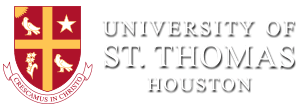Be Bold Blog
The University of St. Thomas (UST) is Houston’s Catholic University, committed to the Catholic intellectual tradition and the dialogue between faith and reason. Our blog is dedicated to helping you explore your future career possibilities and how to make the most of your college experience.
7 Ways to Pay for College

Higher education is one of the most important investments you’ll make in your lifetime. But, for many students and their families, figuring out ways to pay for college can be stressful, especially if it’s your first time doing so.
University of St. Thomas – Houston (UST) is wholly committed to making our programs accessible and affordable for all students. That’s why we put together the following guide to help you understand your options.
Paying for college: 7 options to consider
It’s helpful to know how much your degree is going to cost before you start planning financial aid. UST students can use our Net Price Calculator for freshman or transfer students to help estimate your 2022-23 scholarship and financial aid eligibility. Be sure to complete the entire process to get the best possible results.
Once you have an idea of the price tag, consider these additional ways to pay for college:
1. FAFSA®
The first thing every college student should do is complete the Free Application for Federal Student Aid (FAFSA) form. You must fill it out every school year to determine your eligibility for federal grants and loans. The Federal Student Aid website breaks down the process into easy steps.
You’ll need the following information handy when you sit down to file:
- Name, address, phone number and date of birth
- Driver’s license
- Social security number
- Federal tax information and/or tax returns
- Records of untaxed income (if applicable)
- Savings and checking account balances
- Information about any investments you might have such as stocks, bonds and real estate (not including the home you live in)
When it comes to submitting the FAFSA, earlier is better. There are some awards that are given out on a first-come, first-served basis. For example, if you wanted to start college in September 2023, you should consider filing as soon as October 2022.
2. TAFSA
Texas Application for State Financial (TAFSA) is unique to the Lone Star State. TAFSA makes higher education more accessible for non-documented Texans who are not citizens of the United States or permanent residents.
According to Texas House bill 1403, this allows individuals who are not permanent residents or citizens of the U.S. to pay in-state tuition and receive state financial aid if they have:
- Resided in Texas with a parent or guardian while attending high school in Texas
- Graduated from a public or private high school or received a GED in Texas
- Resided in Texas for the three years leading to graduation (or receipt of a GED), and
- Provided their institutions a signed affidavit indicating an intent to apply for permanent resident status as soon as they are able to do so.
For more information visit CollegeForAllTexans.com.
3. Grants
Grants are a great way to reduce the overall cost of your higher education, as these monetary gifts do not need to be repaid (except under rare circumstances). Most of the grants listed here are awarded through FAFSA but you should also check with your university’s financial aid office.
Pell Grants are offered to undergraduate students in financial need (as determined by FAFSA application) by the U.S. Department of Education.
Federal Supplemental Educational Opportunity grants (FSEOG) are for undergraduates with exceptional financial need and gives priority to students who receive a Federal Pell Grant. Each participating school receives a certain amount of FSEOG funds each year from the government. Once the full amount of the school’s FSEOG funds has been awarded to students, no more FSEOG awards can be made for that year.
Teacher Education Assistance for College and Higher Education (TEACH) grants are for students who meet the following requirements:
- Enrolled in coursework needed to begin a teaching career in a high-need subject area
- Agree to serve as a full-time teacher in a high-need subject area in a public or private elementary or secondary school that serves low-income students
- Are a junior, senior, or graduate student
Texas Equalization Grants are offered to eligible Texas residents enrolled full time or three-quarter time at qualifying nonprofit private colleges and universities in the state. The grant is renewable for students who maintain a 2.5 cumulative GPA and completion of 24 credits in an academic year.
4. Scholarships
Scholarships offer another great way to help pay for college. Organizations of all kinds distribute awards based on merit, need, academic achievement, athletic ability, religious affiliation, major, cultural identity and more.
The first place to look is your university – at UST, more than 85 percent of new freshmen receive a scholarship upon enrolling. Secondly, explore opportunities in your local community, followed by internet search tools like FastWeb, BigFuture and JobStars.
In addition to many other scholarship opportunities, UST is proud to offer the St. Thomas Promise. This program is for incoming, first-time college students with a 3.4 or higher GPA who are from families with annual incomes of $40,000 or less. The St. Thomas Promise offers recipients free tuition as well as tutorial services and a mentor for the first year to help ensure a successful transition to college. It is renewable for up to four years, providing family income remains in the qualifying range.
5. Loans
Many students have to take out loans to cover the gap between financial aid and tuition costs. These debts typically do not require repayment until after you graduate or go below half-time enrollment. It’s important for students to understand the different kinds of loans and their conditions (and to always read the fine print).
Direct Subsidized Loans are distributed to undergraduate students with demonstrated financial need. These loans are preferable to unsubsidized loans (see below) because the government pays the loan interest while you’re in school at least half-time. You also do not have to pay interest for six months after graduation and during deferment.
Direct Unsubsidized Loans are available for undergraduate and graduate students. Unlike subsidized loans, you will be charged interest on this loan from the time the loan is disbursed to you. However, financial need is not required to borrow under this type of loan.
A Parent Loan for Undergraduate Students (PLUS) is an option for undergraduate students whose parents or guardians are willing and able to take out loans on their behalf. This loan is based on the credit score of the borrower, and the federal government determines who is eligible.
Finally, private loans are also available via banks, credit unions and other financial lenders. They are not subsidized and often have higher interest rates and less favorable terms than federal loans.
6. Student loan forgiveness programs
Graduates who go into some professions (e.g., teachers, AmeriCorps volunteers, public workers, military members, etc.) can qualify for student loan forgiveness. These programs can partially or fully pay back your loans after a certain number of years working in the field.
Keep in mind that the eligibility requirements are often very specific, and failure to meet these standards might mean you’ll end up assuming responsibility for paying back your loans.
7. Work study opportunities
Federal Work-Study provides part-time jobs for undergraduate and graduate students with financial need. The program encourages students to perform community service work and/or work that is relevant to their studies. UST students who are eligible for work-study can explore potential job opportunities on Handshake.
Invest in your future at UST
When it comes to ways to pay for college, it’s clear there are several options to choose from. At UST, we understand that every student has unique challenges and circumstances. We’re here to help you find every possible opportunity to make college affordable.
If you’re ready to start your degree, check out Financial Aid at UST or contact the Herzstein Enrollment Center team directly at finaid@stthom.edu.
Ready to take the next step?
Related articles
About UST
The University of St. Thomas (UST) is Houston’s Catholic University, committed to the religious, ethical and intellectual traditions of Catholic higher education. For more than 70 years, we’ve been graduating students like you into successful careers in medicine, education, business, public administration and more – throughout Houston and across the globe.

